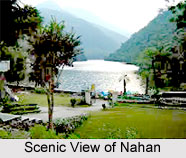 History of Nahan is dealing with the medieval history of princely state of Nahan. Nahan is a well-laid out picturesque town. Nahan is situated on a hill top in the Shivalik Hills, overlooking green hills.
History of Nahan is dealing with the medieval history of princely state of Nahan. Nahan is a well-laid out picturesque town. Nahan is situated on a hill top in the Shivalik Hills, overlooking green hills.
In traditional medieval history of Nahan, the saints and princes are linked with the origin of Nahan. The city of Nahan was founded as in 1621 by Raja Karam Prakash.
Another version of the history of Nahan recalls a saint who lived with a companion named Nahar on the site where the Nahan palace now stands. "Nahar" means "don"t kill" and the town probably takes its name from an incident when a king was trying to kill a lion and the saint said Nahar, that is do not kill it. The name of the saint was Baba Banwari Das.
Nahan has an altitude of 932 metres. Nahan is a good base for visits to the surrounding areas such as Renuka Lake, Paonta Sahib, Trilokpur temple and the Suketi Fossil Park. It has a pleasant climate throughout the year and is watered by a man-made lake and decorated with temples and gardens. Nahan has got the crown to organise the second Municipal Corporation in India, after Kolkata.
The underground sewerage system in this town of Nahan is unbeatable and hence it bears the title to be a neat and clean town. The well planned streets make all the long distances calm and traffic free. The narrow fields of Nahan are used by the pedestrians to move fast on foot to avoid traffic.
The Municipal Corporation Office is also situated near to the Pakka Tank only. The Sirmour district has been extensively criss-crossed by rivers and the streams and most of them having perennial water flow of considerable volume. With the result, the fishing on the rivers and streams has been a pretty old past time in the district. The mulle, Masheer, Gid and Mirror cap varieties are found on large scale, helping in the economic well being of the people.
Industrially, Sirmaur district was not much advanced. The first such unit of Sirmour District was set up in the year 1875, which was taken over by the Government of Himachal Pradesh.
In 1964, the chief items of this foundry were cane crusher, cast iron and black sheet panes flour mills, centrifugal pumps mono-block pump sets and other agricultural implements and accessories. This foundry was over taken by the British East India Company. During the British rule in India, this foundry is situated near famous Kalisthan Temple. Also there is a house opposite to Nahan Foundry which was constructed by Britions of British Government of India for the General Manager of the foundry in the year 1945. It was currently in possession of Government as Sessions House where the District and Sessions Judge of Nahan resides.



















